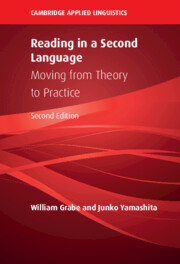Book contents
- Reading in a Second Language
- The Cambridge Applied Linguistics Series
- Reading in a Second Language
- Copyright page
- Dedication
- Contents
- Figures
- Tables
- Preface
- Part I Foundations of Reading
- Part II Patterns of Variation in Reading
- 7 Reading in Different Languages
- 8 L1 and L2 Reading Relationships
- 9 Social Contexts of Reading
- 10 Motivation for Reading
- Part III Developing Reading Comprehension Abilities
- Part IV Expanding Reading Comprehension Skills
- Part V Applications of Reading Research: Instruction and Assessment
- References
- Author Index
- Subject Index
9 - Social Contexts of Reading
from Part II - Patterns of Variation in Reading
Published online by Cambridge University Press: 01 September 2022
- Reading in a Second Language
- The Cambridge Applied Linguistics Series
- Reading in a Second Language
- Copyright page
- Dedication
- Contents
- Figures
- Tables
- Preface
- Part I Foundations of Reading
- Part II Patterns of Variation in Reading
- 7 Reading in Different Languages
- 8 L1 and L2 Reading Relationships
- 9 Social Contexts of Reading
- 10 Motivation for Reading
- Part III Developing Reading Comprehension Abilities
- Part IV Expanding Reading Comprehension Skills
- Part V Applications of Reading Research: Instruction and Assessment
- References
- Author Index
- Subject Index
Summary
Chapter 9: Social Contexts of Reading. This chapter focuses on the many social contexts in which reading is carried out and in which reading develops. We learn to read within a family unit, in various school settings (and their associated goals, expectations, and opportunities), in various classrooms, and in interaction with specific teachers and student peers. Students are also influenced by the wider social and cultural expectations of political, religious, ethnic, economic, and social institutions. Social contexts set the stage for successful reading within the first year of life, and language knowledge, as well as beginning reading, is profoundly shaped in the first five years of life. L2 reading, as it often is learned in childhood or adolescence, is also strongly shaped by social contexts in which learning to read is carried out. Four specific issues include the needs for effective teacher training, the status of minority language instruction in K-12 schools, advanced L2 reading instruction, and most importantly, the role of language and reading exposure throughout a learner’s lifetime. The chapter concludes with implications for instruction.
Keywords
- Type
- Chapter
- Information
- Reading in a Second LanguageMoving from Theory to Practice, pp. 195 - 223Publisher: Cambridge University PressPrint publication year: 2022

